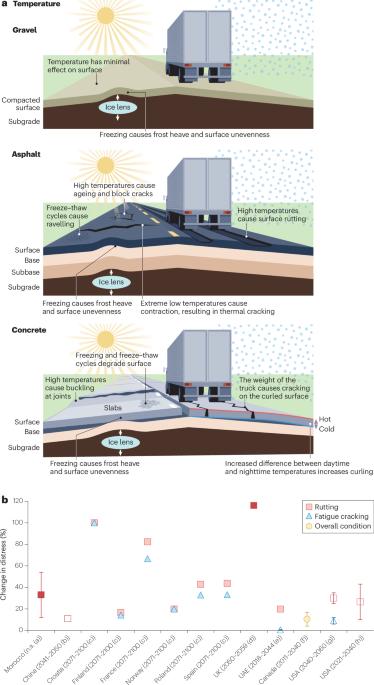Climate change impacts on roadways
引用次数: 0
Abstract
Roadways provide safe and efficient transport and are essential to the function of societies and economies. However, climate change increasingly pushes pavements beyond their engineering limits, leading to deterioration. In this Review, we explore the impacts of climate change on roadways and approaches to mitigate them. Roadways are vulnerable to changes in temperature, precipitation and sea level rise driven by climate change. High temperatures soften asphalt pavements, causing rutting, which is projected to increase by 2% per 1% increase in mean temperature. Increased moisture in the underlying soil caused by precipitation and sea level rise reduces the load-bearing capacity of roadways for months and in some cases halves their lifetime. Roadway closures due to extreme weather events or resulting reconstruction cause delays and detours; by 2100, high tide flooding in the USA is expected to cause delays of 3.4 billion vehicle-hours per year. Climate change is projected to increase national annual costs of pavement maintenance by over US$500 million on average by 2050, depending on the country. Adaptation strategies include adjusting the type of asphalt, reinforcing concrete with steel, stabilizing gravel roads and adding nature-based features. Rapid implementation of policies, guidance on evaluating adaptation alternatives and exploration of the combined impacts of multiple climate stressors are needed. Roadways are damaged by temperature extremes, increased precipitation and sea level rise. This Review discusses the mechanisms and impacts of climate stressors on roadways, the resulting operational and maintenance challenges, and strategies to increase resilience.

气候变化对道路的影响
道路提供安全和有效的运输,对社会和经济的运作至关重要。然而,气候变化日益推动路面超出其工程极限,导致路面恶化。在这篇综述中,我们探讨了气候变化对道路的影响以及缓解这些影响的方法。道路很容易受到气候变化导致的温度、降水和海平面上升的影响。高温软化沥青路面,造成车辙,预计平均温度每增加1%,车辙就会增加2%。由于降水和海平面上升,下层土壤中的水分增加,使道路的承载能力降低了几个月,在某些情况下,使其寿命减半。极端天气事件导致道路封闭或重建造成延误和绕行;到2100年,美国的涨潮洪水预计每年将造成34亿车小时的延误。预计到2050年,气候变化将使国家每年的路面维护费用平均增加5亿美元以上,具体情况视国家而定。适应策略包括调整沥青的类型,用钢筋加固混凝土,稳定砾石道路和增加基于自然的特征。需要快速实施政策,为评估适应备选方案提供指导,并探索多种气候压力源的综合影响。极端温度、降水增加和海平面上升会破坏道路。本综述讨论了气候压力源对道路的机制和影响,由此带来的运营和维护挑战,以及提高弹性的战略。
本文章由计算机程序翻译,如有差异,请以英文原文为准。
求助全文
约1分钟内获得全文
求助全文

 求助内容:
求助内容: 应助结果提醒方式:
应助结果提醒方式:


